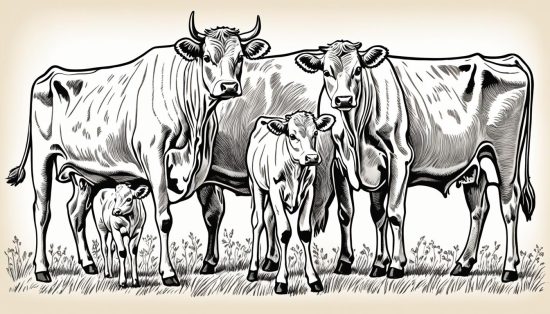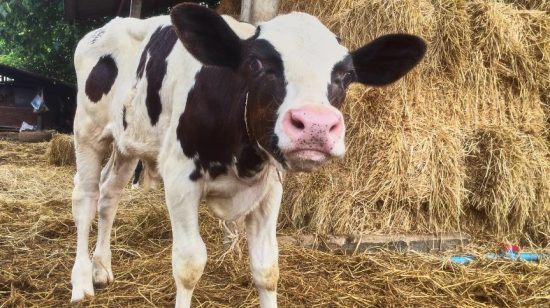How Long Is A Cow Pregnant? The Gestation Period Explained
Discover the duration of a cow’s gestation and the factors that influence it. Learn all about how long a cow is pregnant in our complete guide.
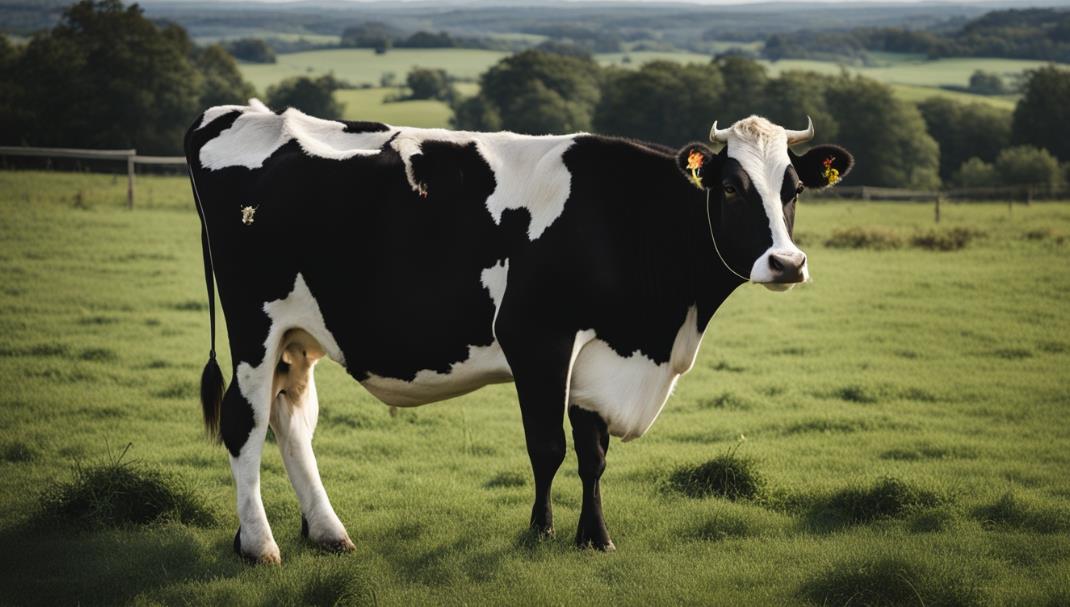
Did you know that the gestation period of a cow can vary significantly from that of humans? While human pregnancy lasts approximately nine months, the duration of a cow’s pregnancy is much longer.
Understanding how long cows are pregnant for is crucial for cattle owners and breeders. Let’s delve into the details of cow pregnancy, exploring the factors that can influence its duration. Whether you’re a farmer or simply curious about the fascinating world of bovine reproduction, this information will provide valuable insights into the gestation period of cows.
Understanding Cow Gestation Length
The gestation length of cows can vary depending on several factors, including the breed of the cow and the sex of the calf. It is important for cattle owners and breeders to have a thorough understanding of gestation length to effectively manage their herds. In this section, we will explore the variations in gestation length in cows and the impact of breed and calf sex on pregnancy duration.
One of the factors that can influence the length of gestation in cows is the breed. Different breeds of cows may have different gestation periods, with some breeds exhibiting shorter durations than others. For example, Black Angus cattle have an average gestation length of around 283 days, while Hereford cattle have an average gestation length of approximately 285 days.
To illustrate the differences in gestation length across breeds, the table below provides a comparison of average gestation periods for some common cow breeds:
| Breed | Average Gestation Length (Days) |
|---|---|
| Black Angus | 283 |
| Hereford | 285 |
| Simmental | 292 |
| Holstein | 280 |
It’s important to note that these are average values, and individual cows within a breed may experience slight variations in gestation length.
How Long Is A Cow Pregnant?
To gain a comprehensive understanding of cow pregnancy, let’s take a detailed look at the duration of gestation. Throughout the entire pregnancy journey, cows go through various stages and milestones that contribute to the development of their calves.
The duration of a cow’s pregnancy, also known as the cow pregnancy duration or length of cow gestation, typically lasts around 283 to 289 days, depending on several factors. It is important to note that individual variations can occur, and the actual length may vary within this timeframe.
During the first stage of pregnancy, known as the embryonic development stage, the fertilized egg undergoes cellular division and multiplication. It then implants into the uterine wall, which marks the beginning of the gestation period. This stage typically lasts for the initial 40 to 45 days.
Following the embryonic stage, the fetal development stage begins. This stage is characterized by the growth and development of the calf within the cow’s womb. As the weeks progress, the calf’s organs, skeletal system, and overall body structure form and mature. By the end of the gestation period, the calf is fully developed and ready for birth.
It is important to note that the duration of bovine pregnancy can vary depending on certain factors. Factors such as breed, health conditions, and environmental factors can influence the length of gestation. Additionally, variations can occur in specific breeds, leading to slightly shorter or longer gestation periods.
By understanding the specific timeline of a cow’s pregnancy, farmers and breeders can effectively manage and plan for the arrival of new calves. It allows them to provide the necessary care, nutrition, and veterinary attention to ensure the health and well-being of both the cow and the calf.
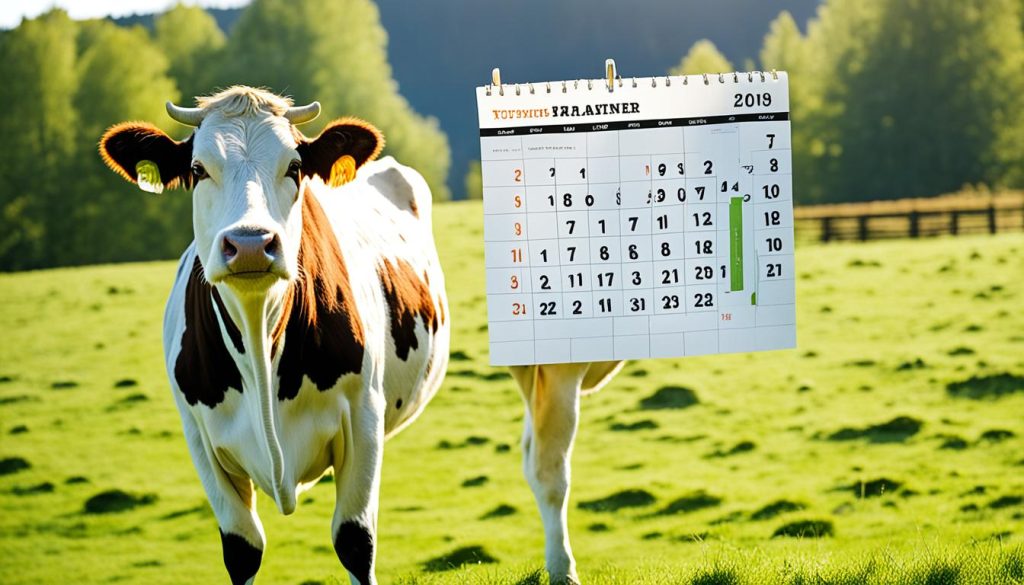
Factors That Influence Cow Pregnancy Duration
The Role of Nutrition in Gestation
Proper nutrition plays a crucial role in supporting the growth and development of the fetus during cow gestation. A well-balanced diet that meets the nutritional needs of the cow is essential for maintaining the health of both the mother and the calf. The cow’s diet should include a variety of high-quality forages, grains, and supplements to provide adequate energy, protein, vitamins, and minerals.
Nutrition influences the length of cow pregnancy as it affects the cow’s overall health and reproductive function. It is essential to provide the cow with optimal nutrition throughout the entire gestation period to ensure a healthy and successful pregnancy.
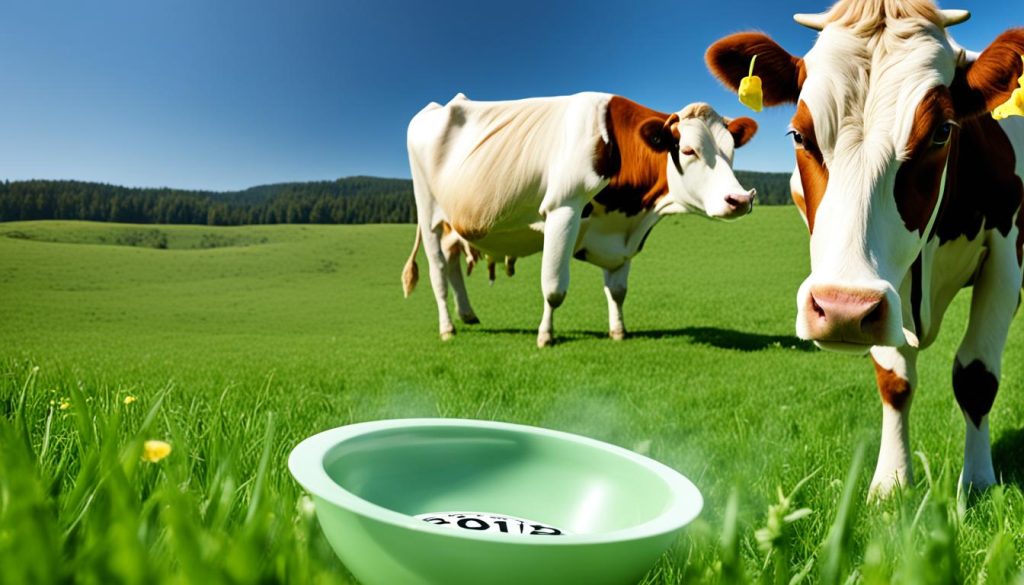
Identifying Effects of Disease on Gestation
Diseases or health conditions can have a significant impact on the length of a cow’s pregnancy. Certain diseases can lead to complications that may result in premature delivery or extended gestation periods. It is crucial to monitor the health of the cow and promptly address any signs of illness or disease that may affect gestation.
Diseases affecting cow gestation can include reproductive disorders, such as infectious diseases, metabolic disorders, and hormonal imbalances. Regular veterinary care, including routine vaccinations and health screenings, can help prevent and detect diseases that may interfere with the normal gestation process.
Breed-Specific Gestation Variations
Different breeds of cows may naturally have variations in their gestation periods. Breed-specific variations can range from a few days to several weeks. It is important for cattle owners and breeders to be aware of the average gestation length for their specific breed and closely monitor individual cows for signs of impending labor.
Certain breeds, such as Angus or Hereford, may have shorter gestation lengths compared to other larger and late-maturing breeds. Understanding these breed-specific variations can help farmers and breeders properly manage their herds, plan for calving, and ensure the overall reproductive success of their cattle.
Table: Summary of Factors Affecting Cow Pregnancy Duration
| Factor | Impact on Pregnancy Duration |
|---|---|
| Nutrition | Adequate nutrition supports fetal growth and development, influencing the length of gestation. |
| Diseases | Illness or health conditions can lead to complications and potentially extend or shorten the gestation period. |
| Breed-specific variations | Different breeds may naturally have variations in their gestation lengths. |
How Diet Affects the Cow Gestation Timeline
The duration of a cow’s pregnancy, or gestation period, can be significantly influenced by its diet. Providing a well-balanced and nutritious diet is crucial for the health of both the cow and the developing fetus. In this section, we will explore the impact of diet on the timeline of a cow’s gestation and highlight the importance of proper nutrition.
A cow’s diet during gestation should consist of high-quality forage, grains, and mineral supplements to meet its nutritional requirements. Adequate protein, energy, vitamins, and minerals are essential for supporting the growth and development of the fetus, as well as maintaining the cow’s own health.
Research has shown that nutritional deficiencies or imbalances can lead to complications during pregnancy and may even result in prolonged gestation. Insufficient nutrition can affect the cow’s ability to conceive, maintain pregnancy, and give birth to a healthy calf.
One aspect to consider is the impact of feeding on gestation length. Overfeeding or underfeeding can have adverse effects on the cow’s reproductive system and overall health. It is important to work with a veterinarian or a qualified nutritionist to develop a feeding plan that meets the specific needs of your cows.
| Effects of Diet on Cow Gestation | Consequences |
|---|---|
| Inadequate nutrition | Increased risk of complications, longer gestation period |
| Imbalanced diet | Reduced fertility, poor conception rates |
| Insufficient energy | Low birth weights, weak calves |
| Mineral deficiencies | Developmental abnormalities, skeletal issues |
By ensuring that cows receive proper nutrition during gestation, farmers can positively impact the length of the pregnancy and improve overall reproductive success. Consult with experts in the field to develop a feeding program that takes into account the specific needs of your cattle and maximizes their reproductive potential.
Health and Medical Interventions During Bovine Pregnancy
Maintaining the health of pregnant cows is crucial for successful gestation and calf development. In this section, we will discuss various health and medical interventions that can be implemented during bovine pregnancy. These interventions play a significant role in ensuring the well-being of both the cow and the growing fetus.
Managing Pregnancy Toxaemia in Cows
Pregnancy toxaemia, also known as ketosis, is a metabolic disorder that can occur in pregnant cows. It is characterized by elevated blood ketone levels and can have detrimental effects on the health of both the cow and her developing calf. Early detection and management of pregnancy toxaemia are essential for the successful outcome of the pregnancy.
One of the key interventions for managing pregnancy toxaemia is providing proper nutrition to the affected cow. A well-balanced diet, with adequate energy and high-quality protein, can help alleviate the condition. Close monitoring of the cow’s condition and regular veterinary check-ups are also crucial for effective management.
Preventative Care and Vaccinations for Bovine Viral Diarrhoea (BVD)
Bovine viral diarrhoea (BVD) is a highly contagious viral infection that can pose risks to pregnant cows and their offspring. Vaccination is a crucial preventative measure to protect the herd from BVD and reduce the transmission of the virus. Administering the appropriate BVD vaccines according to a veterinarian’s recommendation can significantly reduce the incidence and impact of the disease.
In addition to vaccinations, implementing biosecurity measures can help prevent the introduction and spread of BVD in the herd. This includes quarantining new animals, maintaining appropriate hygiene practices, and controlling insect vectors that can transmit the virus.

By implementing health interventions such as managing pregnancy toxaemia and administering preventative care and vaccinations for BVD, cattle owners can ensure the well-being of their pregnant cows and increase the likelihood of a successful pregnancy and healthy calves.
Reproductive Health: Postpartum Recovery and Conceiving Again
The recovery of a cow after giving birth, also known as the postpartum period, is a critical time for both the cow and its ability to conceive again. A thorough understanding of postpartum recovery in cows is essential for ensuring their reproductive health and maximizing the chances of successful pregnancies in the future.
During the postpartum period, cows undergo significant physiological changes as they recover from the birthing process. The body goes through a process known as involution, where the uterus returns to its normal size and position. This recovery period typically lasts between 30 and 45 days, but can vary depending on factors such as breed and individual health.
Proper nutrition during the postpartum period plays a crucial role in supporting the cow’s recovery and reproductive health. Providing a well-balanced diet that meets the cow’s nutritional requirements is essential for optimal postpartum recovery. It helps replenish the cow’s energy reserves, support milk production, and facilitate the return to cyclicity.
Additionally, postpartum management practices, such as regular health check-ups, monitoring body condition, and addressing any health issues promptly, are crucial to ensure a smooth recovery and minimize the risk of complications. It is also important to provide adequate bedding and a clean environment to reduce the chances of infections.
When it comes to conceiving again after giving birth, various factors can influence a cow’s ability to conceive successfully. These factors include the cow’s overall reproductive health, postpartum uterine health, body condition, and any underlying health conditions. A cow that has experienced a difficult or prolonged calving process may require additional veterinary care and monitoring to optimize its chances of conceiving again.
Cows that experience prolonged postpartum anestrus, the period when a cow is not cycling, may require intervention to induce ovulation and kickstart their reproductive cycle. This can be done through hormonal treatments or the use of synchronization protocols under the guidance of a veterinarian.
In conclusion, the postpartum recovery period is crucial for a cow’s reproductive health and its ability to conceive again. Providing the necessary care, nutrition, and management practices during this period can significantly improve the chances of successful pregnancies and maintain a healthy breeding herd.
Enhancing Herd Fertility: Best Practices for Successful Breeding
Ensuring optimal herd fertility is essential for cattle farmers and breeders. When it comes to successful breeding, there are several best practices that can significantly improve herd fertility and increase the chances of successful pregnancies. By implementing these strategies and considering various factors that impact fertility, you can maximize the reproductive success of your cow herd.
First and foremost, proper nutrition is key to enhancing herd fertility. Providing your cows with a well-balanced diet that meets their nutritional requirements is essential. Make sure to provide them with high-quality forage, a balanced mineral supplementation, and access to fresh and clean water. This will not only support the overall health and well-being of your cows, but also facilitate optimal reproductive function.
In addition to nutrition, it is important to prioritize regular health check-ups and veterinary care for your cattle. Routine vaccinations and preventative measures against common diseases can greatly contribute to maintaining herd fertility. By managing the reproductive health of your cows through timely interventions, you can reduce the risk of diseases impacting their fertility and reproductive potential.
Lastly, implementing sound breeding practices can further improve herd fertility. Keeping accurate records of breeding dates, tracking heat cycles, and utilizing proven breeding techniques, such as artificial insemination or natural service from high-quality bulls, can significantly increase the chances of successful conception. Regular monitoring and observation of your cows’ reproductive behavior will also enable you to identify any potential issues or fertility concerns early on, allowing for prompt intervention.
FAQs on How long is a cow pregnant?
What factors can influence the duration of a cow’s pregnancy?
Several factors can affect the length of a cow’s pregnancy. These include breed, the sex of the calf, nutrition, and the cow’s overall health and well-being. Each of these factors can contribute to variations in the gestation period.
How many times can a cow get pregnant?
A cow can get pregnant multiple times throughout her life. In general, cows are capable of becoming pregnant again shortly after giving birth, usually within 60 to 90 days. However, it is important to consider the individual cow’s health and reproductive capabilities when determining the ideal intervals between pregnancies.
How long after a cow gives birth can she get pregnant again?
Cows have the ability to conceive again shortly after giving birth. Typically, a cow can become pregnant again within 60 to 90 days after calving. However, it is important to closely monitor the cow’s health and reproductive condition to ensure she is ready for another pregnancy.
How many months is a cow pregnant?
The gestation period for cows is typically around 9 months. This translates to roughly 283 to 285 days, although the specific duration can vary based on factors such as breed and individual circumstances.

